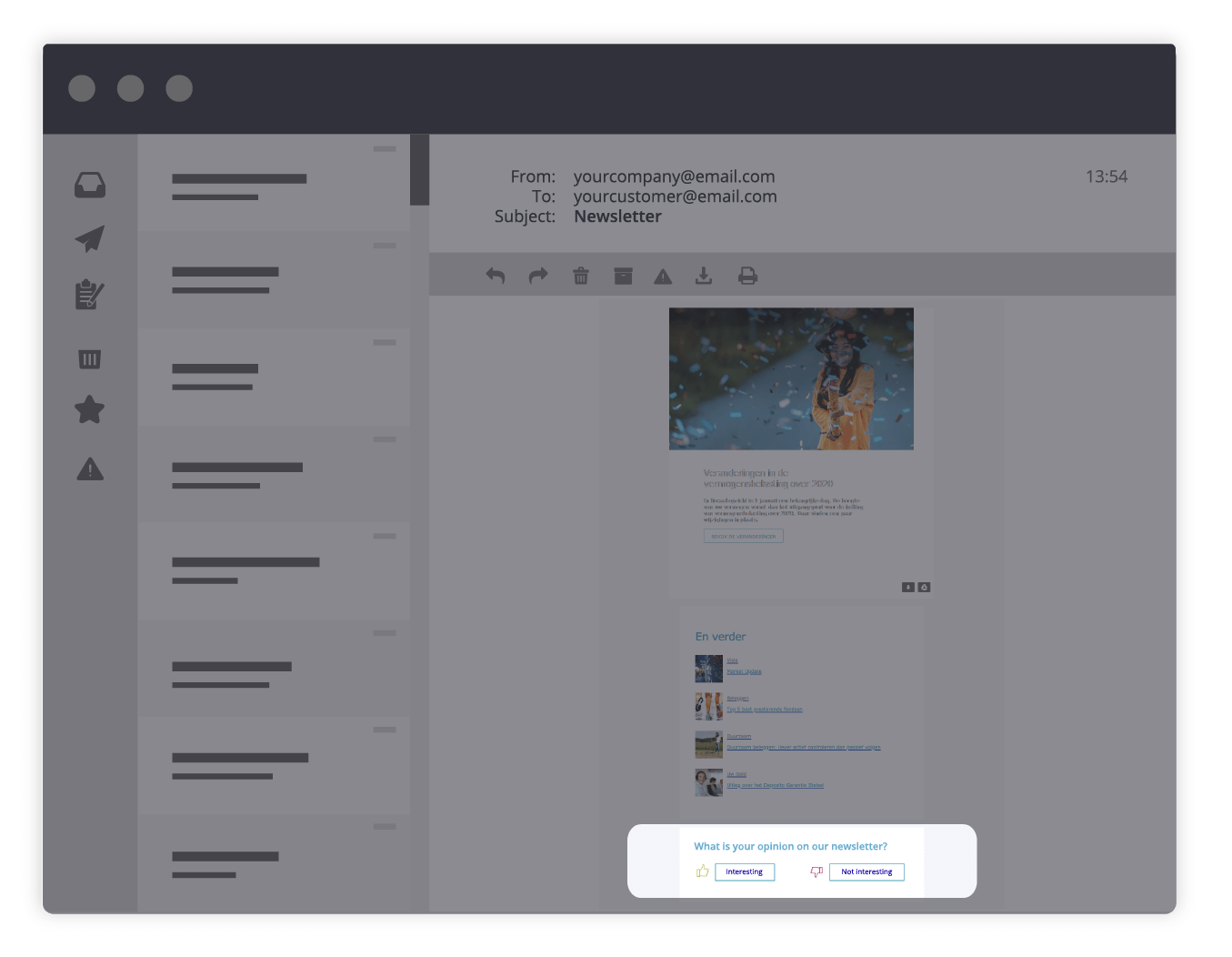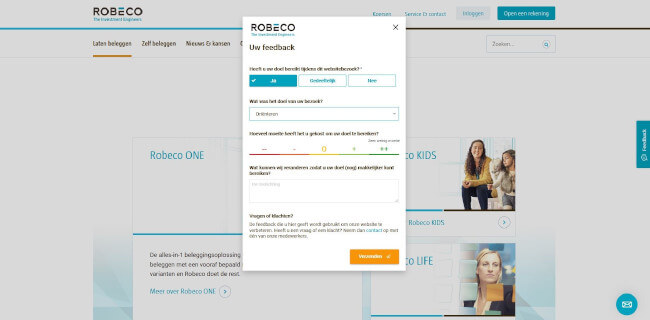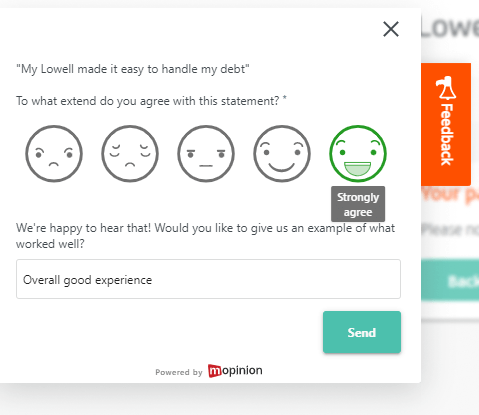Customer expectations are growing, and digital journeys are becoming an increasingly important part of how insurance and financial services organisations engage with their customers, understand their expectations, and ultimately deliver on them. According to Bloomreach, “the sheer volume of questions and claims, legacy systems, ancient technology, and a distorted view of the customer journey are the top issues that have long plagued banks and insurance companies across the world.”
So what is the key to a smooth online journey for these organisations? The answer lies in user feedback.
Let’s take a look at how some prominent companies in the insurance and financial services industries use feedback to improve the customer journey. We’ll also share some tips and tricks that we learned from these feedback use cases.
User feedback for financial services and insurance organisations
As consumers continue to become more digitally savvy, finance and insurance organisations are seeking new ways to cater to consumer needs in a digital environment. Whether that’s raising awareness towards making mobile payments, leveraging new technology that makes financial activities more fun, or using personalisation technology to create a more engaging experience, there’s a lot of progress to be made.
A closer look at the online journey
In our previous post about optimising the online journey for financial institutions, Mopinion mentions the most important stages of the customer journey in finance.
Note: this journey is often also quite similar to that of the insurance industry. Hence the intertwining of these two industries in one post.
- Discover
- Explore
- Buy
- Use
- Ask
- Engage
And as you might have suspected, each of these stages requires a different approach to asking feedback from your customers.
Discover & Explore
The discover and explore stages of the customer journey are intended for spreading awareness and information among your prospective customers. If online touchpoints within these stages are not fully optimised, you’ll lose business before you were even able to show these prospects your worth.
Therefore you need a solution for measuring how your touchpoints are performing. In this stage, the most effective form of digital feedback is website content feedback, as it is primarily information that visitors are looking for. This type of feedback is typically found on websites and mobile apps in the form of a feedback button, embedded right on the page or using any number of triggers (i.e. scrolling, time on page, etc) to prompt a feedback form.
Buy
Next up is the actual purchase or sign up. Whether that is opening a new account or signing a contract agreement, this is an important stage because it will require you to provide an easy transition from exploration/research to becoming a customer. In this stage, you’ll also want the user experience to be in tip-top shape so as not to discourage customers from converting.
Use
Woohoo! You have a new customer. As the customer completes onboarding, it is up to the organisation to make sure the customer is all set up. This is your chance to foster quality customer interactions, by providing personalised and relevant interactions.
With pension providers, for example, there are quite a few onboarding emails going out to users post-purchase or post-sign up. There is the confirmation of sign up, then the first welcome email followed by emails with requests for missing information, as well as instructions on how to continue setting up the account or set up your monthly deposit / investment. This is a great place to start when it comes to gathering feedback. Make sure you’re sending out the right message to these recipients! See how Robeco does this below…
Ask
Now we transition into the customer service stages of the journey. In this stage, it is critical that you focus on making sure the customer remains content with the service and finds information they need when they need it! This is the stage where customers are likely to consult FAQs and other online services.
For example, in the banking industry, digital self-service enables customers to carry out banking activities on their own, from checking and account details to paying off bills and clarifying product information.
Leverage feedback here to ensure your self-service tools and website and mobile app content are useful to your customers.
Engage
This is essentially an ongoing engagement that the organisation has with the customer after they’ve converted. Engagement may come in the form of newsletters, up-selling, resolving issues that arise, etc.
If we look at insurance websites or mobile apps, the MyAccount portal is often used for reviewing current information regarding healthcare costs, submitting declarations, reviewing healthcare costs, checking up on the financial overview and more. Hence a great place to measure user engagement and satisfaction with feedback surveys.

Free White Paper: Digital Feedback and the Finance Industry
A guide about how financial institutions can collect feedback on their digital channels and the digitising Financial Industry.
User cases from financial services and insurance organisations
With these stages in mind, let’s take a look at how a few organisations conduct their user feedback programs in practice!
How Robeco uses customer feedback
Robeco is a well-known and international asset manager located in the Netherlands. Over the years, the organisation has evolved from a traditional asset manager to an omnichannel service provider. Today consumers can invest online at Robeco Retail, benefiting from the advantages of a large institutional investor, tailor-made for consumers.
With that transition, Robeco became very well-seasoned in gathering and utilising the insights from customer feedback – all for the betterment of its online channels.
So how do they leverage customer feedback?
Throughout the website, Robeco’s customers can leave feedback through the feedback button – a passive button visible to customers on the right side of the website screen. The Robeco team also actively requests feedback across various touchpoints on the website (e.g. after making a transaction), in service emails and customer surveys. This was one of the reasons they started using Mopinion, as the solution provided them with the ability to measure feedback consistently across these channels.

Example of a Robeco service email
In fact, the team uses many types of questions in their forms depending on where a customer is at in the journey. Did the visitor reach his/her goal (GCR)? How much effort did it take (CES)? How does the customer feel about the level of service in general? The trigger for these feedback forms varies from behaviour on the website (for example, when leaving a page or after a fund purchase) to an annual invitation for general feedback on Robeco’s services.

Example of a GCR survey
The team uses important customer experience metrics (such as the CSAT, GCR and CES) that are visualised in their dashboards. This helps ensure that they can keep a close eye on the customer experience. Every month, these results are fed back to the various teams (Investment Services, IT and Marketing) and deeper analyses are carried out to explain trends or to determine the need for further investigation. Based on the results, sessions with a multidisciplinary team are then organised to deal with an issue.
As you can see they have a very systematic approach to gathering and analysing this feedback that works well for them. These insights give them the data they need to measure the impact of new implementations on their website’s satisfaction which is a huge plus.
Curious what other findings and results they had? Read the entire Robeco story here.
How Lowell Nordics uses customer feedback
Lowell Nordics – a financial services organisation which serves the credit management value chain – has a unique challenge in that the team needed to localise their feedback software for four different countries and implement it on 12 separate platforms – all which catered to the different needs and regulations of each country.
Currently the team at Lowell uses five different feedback forms: two of which are for customers and the other three for clients. Some of the forms collect feedback at specific touchpoints in the journey, whilst others are intended purely for gathering open feedback (which are, of course, tied to certain metrics). The main metrics leveraged included Customer Satisfaction, Net Promoter Score and an ‘Ease of Use’ rating.
The forms used by Lowell websites are always active, but are limited by cookies to ensure users aren’t routinely ‘bombarded’ with surveys.

Example of an ‘Ease of Use’ survey.
Nearly all Lowell’s surveys contain open-answer type questions. For these surveys, Lowell has email alerts configured, so they can keep an eye on the insights easily. That way the product owners in each of the countries can stay informed of the performance of each individual website in monthly or bi-monthly meetings.
All in all, the data gathered from these forms has effectively created an internal awareness about user journeys and revealed some long-neglected content.
Get the full feedback story on Lowell Nordics here.
How Allianz uses customer feedback
Allianz forms part of Allianz Group which is one of the largest, multinational financial services companies in the world. Originally, Allianz sold its products and services through intermediaries. As a result, Allianz’s website didn’t play a major role. However, nowadays, with so much more business taking place online, the website has become increasingly important to the success of the organisation.
Allianz collects customer feedback primarily to discover obstacles within the customer journey.
Allianz leverages both passive and active feedback form on its website. Passive feedback is feedback collected by a feedback button on the website. The visitors that fill in these forms essentially let the team at Allianz know what they think of the website.

To prevent drop offs in conversion, however, Allianz takes a different approach. They collect active feedback via an exit survey, which is a short questionnaire that asks visitors to share why they are leaving the site or page. Often this feedback form appears just before someone ‘threatens’ to leave the page and moves the mouse towards the exit, or if someone is on a page for a certain amount of time.
Need an example? With one of its insurance policies, Allianz noticed that the conversion on mobile was rather low. Many users clicked on the receipt, but were unable to continue. There was no clickable cross or button, so users got stuck and ended up leaving. By having a user feedback form available at this touchpoint, Allianz was able to learn more about the problem occurring.
Read the full Allianz feedback story here.
How Reale Seguros uses customer feedback
Reale Seguros is a relatively new subsidiary of Reale Group, an international group operating in Italy and Spain. With nearly 4 million policyholders, it is a strong market player that offers its proposition in the insurance, banking, real estate and services sectors.
The Reale Seguros website is a place where the organisation can create brand awareness, as well as support its customers, help them achieve various online tasks and access the user portals. That being said, it quickly deployed a feedback solution that would help improve its online processes for both policy holders and prospective customers.
Reale Seguros leverages feedback in two different ways: on the homepage of its website and within the user portal. The homepage survey is deployed passively, meaning that it is always visible via a feedback button on the side of the page, whereas the user portal survey is deployed actively (appearing around 15 seconds after logging in).
One of their key metrics, Net Promoter Score (NPS), is used across the entire organisation (as well as the Group) and enables Reale Seguros to gather loyalty insights from its existing customers. This is, of course, integrated into their feedback forms.

Example of an NPS survey.
“One of the most impactful optimisations we have made since using Mopinion was an issue we were experiencing with our login page. Thanks to the feedback we received from customers, we were made aware of the fact that not all customers were able to access the portal. This was a huge discovery seeing as how this problem was essentially preventing these customers from conducting important tasks within the portal.”
Reale Seguros has since also modified the way in which they display their policies to their customers. Thanks to the feedback received, they were able to make data-informed decisions about how to display these policies in a way that better catered to their customers.
Read the Reale Seguros feedback story here.
What we can learn from these use cases
There are many lessons to be learned from how these four organisations have achieved success with feedback. Here is our list of learnings, based on these Mopinion customer stories alone.
A common theme among many of these feedback use cases is that content, user portals and mobile channels are a huge part of the success of organisations in these industries.
Content matters
Insurance and financial services organisations have to put out a lot of information in order for their prospects and customers to achieve their goals. Whether that’s details regarding a particular insurance policy or banking account types. That means that they must make sure this content is fully optimised and easily accessible to online visitors.
For example, given the amount of banking choices today, it is imperative that banks have the information their prospects are looking for readily available. For example, on the website of TSB, a large bank in the UK, there is a lot of content around account types such as ‘Classic Plus’, ‘Classic’, ‘Silver’, etc. These content pages are a great example of the information prospects are looking for. In order to be competitive, these pages need to be fully optimised.
Additionally, these industries will need to pay close attention to content in emails as well – as that plays a huge factor in their customer engagement levels. Robeco has great examples of how to use customer feedback to manage and optimise service emails.
User portals are a critical source of feedback
As you can see from many of the stories shared above, online user portals are a critical tool for organisations in finance and insurance. As customers grow more tech savvy, the use of these portals will only increase and therefore need to be up to par with the needs of the customer.
With these portals (on both websites and in-app), it’s important to always have a feedback button readily available so that your customers can provide feedback on bugs, page errors, missing information and so on.
Mobile channels must be fully optimised
We’ve said it before and we’ll say it again. For these industries – and particularly the financial services sector – mobile channels should be a point of focus. In fact, with 30% more apps compared to other industries, one might even go as far as to say they’ve become a digital priority among these institutions.

Guide to In-App Feedback for Financial institutions
Ready to collect feedback in your app?
This increased level of competition has urged many companies to invest in this particular channel. What they don’t yet realise however is that collecting in-app feedback will not only give them the insights they need to boost user experience and the usability of their app, but also to keep users loyal to their brand.
Pave your path in the industry with user feedback!
Collecting feedback and putting it into action is a great way to improve the online CX. And that’s especially important in the financial services and insurance industries, where there is a great deal of online competition.
So try out feedback and see what works best for your company, keeping these learnings in mind.
Looking for more content on the finance industry? Be sure to check out our finance industry benchmark results and see how organisations like yours are currently gathering and analysing feedback!
Ready to see Mopinion in action?
Want to learn more about Mopinion’s all-in-1 user feedback platform? Don’t be shy and take our software for a spin! Do you prefer it a bit more personal? Just book a demo. One of our feedback pro’s will guide you through the software and answer any questions you may have.






